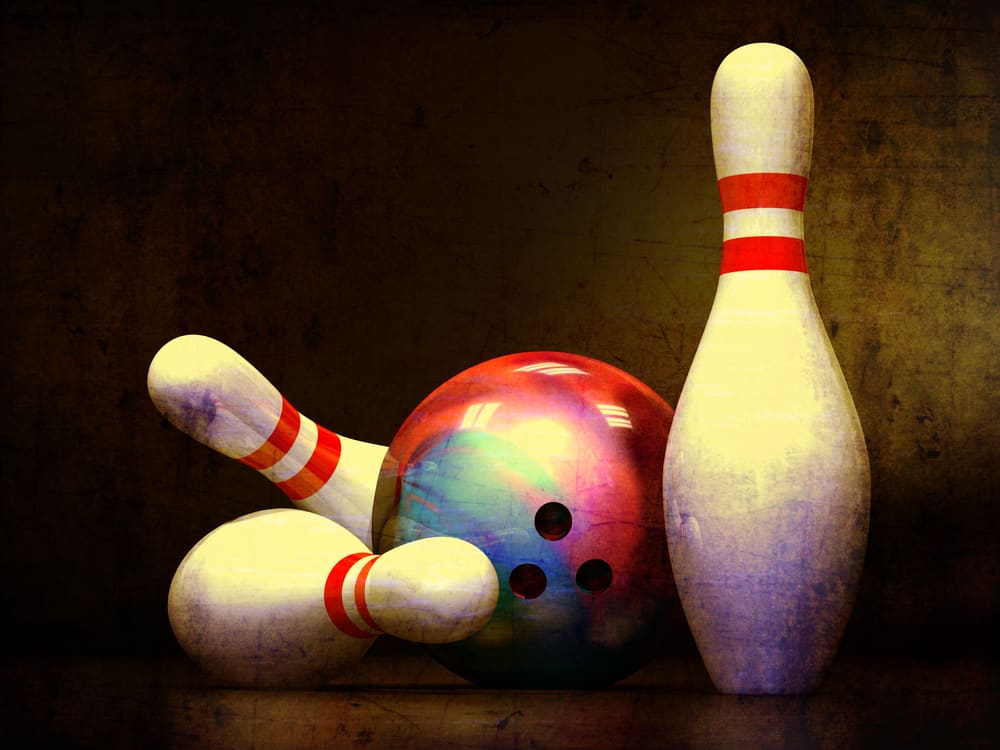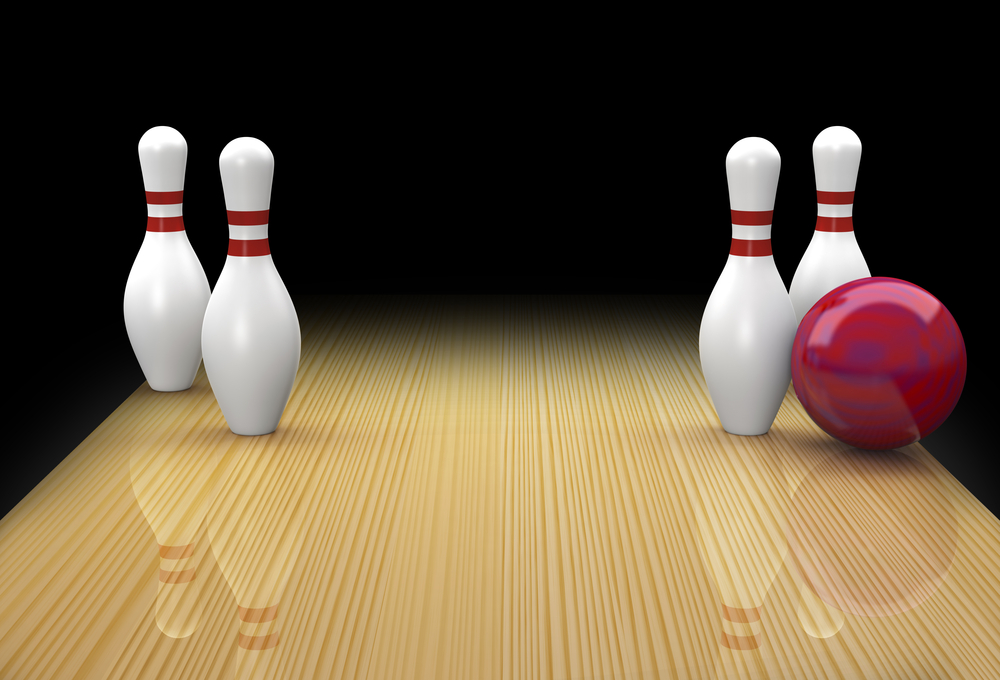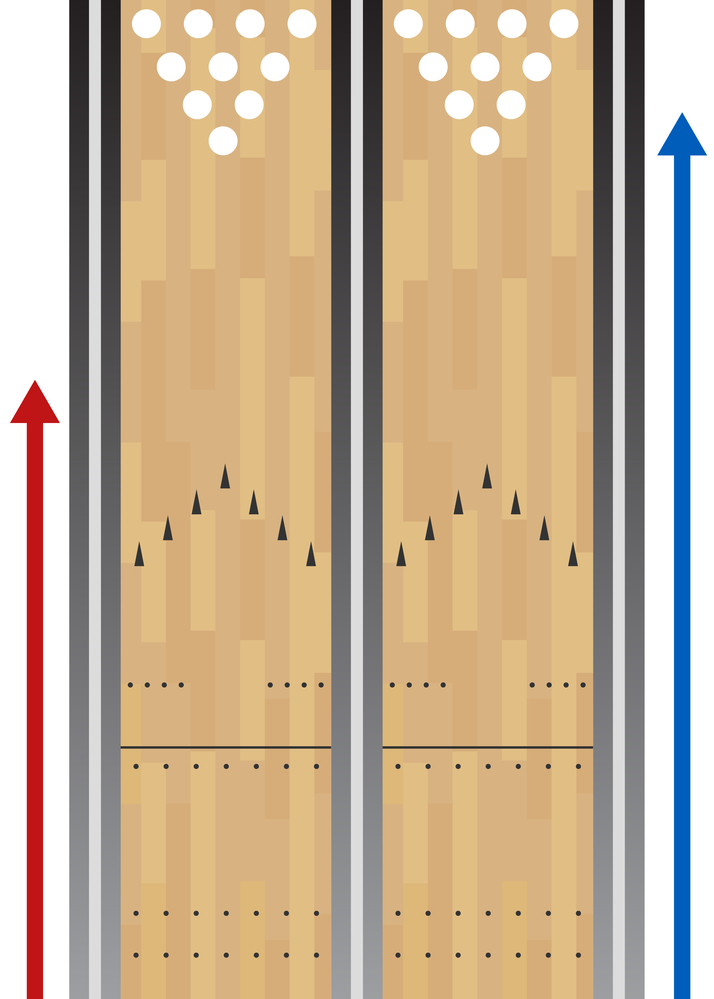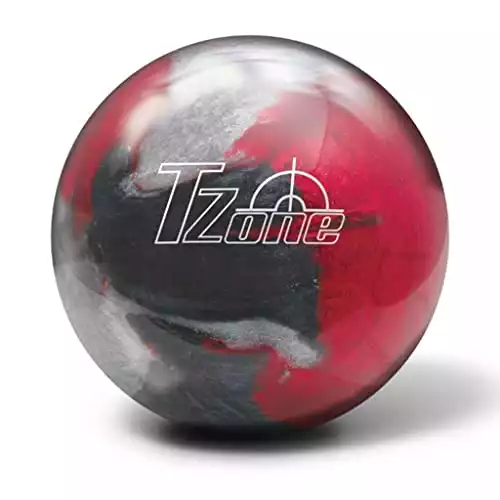
You did everything right. You lined up the shot, used your tried and true target marks, the release was perfect, and your hook ball went right into the pocket, but…you missed the strike. That’s okay. It happens!
The important thing to do is not let the miss get to you; regroup, think about your spare system, and use your best bowling ball for spares on your second throw to get yourself a spare!
A spare in bowling is where you have missed some pins on your first throw, and you use the second throw of your turn to get the rest of the pins. While a strike carries over the points from your next two throws, a spare only carries over the points from your next throw. This is still an advantage to your score, and it is important to practice how to pick up those remaining pins and give yourself an edge.
If you're in a hurry and only looking for our the best spare bowling balls, we recommend the Hammer Widow spare bowling ball. This polyester bowling ball features a gas mask core and 2,000 Abralon Powerhouse factory finish.
Click here to read the latest reviews on the Hammer Widow spare bowling ball.
Contents
Why Do Some Bowlers Use a Strike Ball and a Spare Ball?

When trying to bowl strikes, many bowlers choose to use a heavy performance ball with a high hook potential and more backend action for revs.
Many choose to use these powerful balls to get fast high hook throws with a lot of revs and build enough power to blast through the pins.
Unfortunately, this method is not one hundred percent effective, and tricky spares and splits can occur after the bowling ball has blasted through the pocket.
This is when the bowler needs to switch up their tactics.
If you encounter a tricky spare or split, you do not need raw power and speed but precision and finesse. When looking to be careful and aim, a heavy ball with high hook potential is not always the greatest tool to use.
This is why many bowlers choose to switch up their bowling balls when aiming for spares. Instead of a heavy-hitting hook bowl, bowlers generally pick a lighter ball with low hook potential and low backend action for their second throw. The best spare bowling ball is often a plastic or polyester.
This choice is made to get a longer skid in the roll, as well a straight trajectory in your roll to improve your accuracy and to prevent unique oil patterns from impacting your spare conversions.
Key Takeaways
- Spare Bowling Balls: Use a straight ball, like a plastic or polyester spare ball, for precision and accuracy in hitting remaining pins after a missed strike. Due to their low hook potential and straight trajectory, they are ideal for tricky spares and splits.
- Spare System Tactics: Employ the 3-6-9 or 2-4-6 spare systems to adjust your position or target marks on the lane, enhancing your ability to pick up spares accurately. These systems depend on the pins left standing and require practice for mastery.
- Bowling Ball Weight: Select a spare ball that's the same weight or slightly lighter than your strike ball. This helps maintain balance, timing, and consistency in throws, contributing to better control and accuracy.
- Drilling Grip Styles: Match your spare ball's grip and hole layout with your strike ball to keep your movements natural and comfortable, focusing on straight shots for spare pickups.
- Improving Spare Pickups: Adjust your stance, visualize the ball's trajectory, and target further down the lane to increase the chances of picking up spares. A 'broken wrist' position can also reduce revs, aiding in accuracy.
What Is the Best Bowling Ball for Spares?

When bowling to pick up spares the main goal is accuracy and decreasing your margin of error with your aim. As you look to keep your aim straight you don’t want a reactive ball or ball with a high hook potential.
Instead, bowlers turn to bowling balls with more skid, less backend reaction, and low hook potential to increase the accuracy of their throws.
When selecting a spare ball many bowlers choose to go with plastic bowling balls. These balls are perfect for the precision and accuracy you need when trying to pick up a spare due to their long skid and less backend reaction.
Plastic balls also have a larger margin of error, so if something goes wrong in your stance, throw or release you have more wiggle room to fix these mistakes.
What Is the Best Weight for a Spare Ball?
When selecting the weight of your spare ball it is important to choose a weight that works best for you. Generally, when picking a bowling ball weight, you should take your weight in pounds and divide it by 11.
This will give you a good starting weight to try when selecting your ball and you can experiment on which weight works for you. It is also a wise idea to go a few pounds lower than your suggested weight and work your way up from there.
Once you find the bowling ball weight that is comfortable for you for your regular gameplay its time to figure out your spare ball weight. The common practice is that when you use a strike and a spare ball combo, your spare ball is the same weight or a pound lighter than your strike ball.
This is done to help you keep your balance and timing consistent and offer better control of the ball and its release.
"TZone Deep Space" by Brunswick
A great option to consider is the TZone Deep Space bowling ball by Brunswick. A plastic ball that is great for straight line bowling. The Brunswick TZone Deep Space is not to be overlooked. It's also a great entry-level bowling ball for beginners trying to get a handle on different lane conditions.
Should Your Spare Ball Be a Different Weight from Your Strike Ball?
In all honesty, the answer to this question varies. You should always bowl with what is most comfortable for you and what works for you.
Your goal is also to increase your control and aim in your throws for straight shots, so you want your movements to be natural and comfortable so you can focus on aiming.
Many people find that having your spare ball the same weight or a pound or two lighter than their strike ball helps keeps their throws consistent. By doing this they are able to control the ball better for the types of throws needed to accurately pick up spare pins.
Should You Use a Fingertip or Conventional Drill on Spare Balls?
When drilling the grip for your spare ball it is important to keep the grip and hole layout the same as your strike ball.
Doing this allows you to keep your timing, balance, and stance the same to keep your pace and throws consistent. The key is to keep yourself comfortable and your movements natural so you can focus on this shift in your aim.
If you are new to bowling we would probably recommend you use the conventional grip then, since that is the most common grip used in house (bowling alley rental) balls.
This grip goes down to the second knuckle on your middle and ring finger and the first knuckle on your thumb and is the usual grip to start out with for beginners. It is also a grip that can help you practice straight throws instead of hook throws.
How To Increase Spare Pick Ups
| Feature | Description | Benefit |
|---|---|---|
| Spare Ball Type | Plastic or polyester, low hook potential | Enhances accuracy for spares |
| Weight Strategy | Spare ball weight equals strike ball or 1 pound lighter | Maintains balance and control |
| Grip Type | Match spare ball grip with strike ball | Ensures consistency in throws |
| 3-6-9 Spare System | Adjust left foot position by 3, 6, or 9 boards opposite the pin(s) left standing | Simplifies aiming for spares |
| 2-4-6 Spare System | Adjust target marks, not starting position, based on pins left standing | Provides precision for experienced bowlers |
What is the 3-6-9 Spare System?
The 3-6-9 spare system is a method that many bowlers use to help themselves adjust and aim for leftover pins. The mechanics of this method are relatively easy to use and execute, making the 3-6-9 spare system one of the most popular methods of spare adjustments amongst bowlers, here is how it works.
To begin you need to know two key things about your bowling approach and throw. Those key things are what board your left foot is resting on if you are right side dominant (reverse for left side), and the target mark, or strike point, that you are aiming for.
Using these two factors, you execute the 3-6-9 spare system by adjusting your left foot in the opposite direction of the pin you want to pick up by 3 boards per pin.
For example, say you roll your ball but pin number 2 remains standing. Since your left foot started on the 19th board you would shift that foot over 3 boards to the right, in the opposite direction of the pin.
Once your left foot rests on the 16th board, you use your same target mark as an aiming point and execute your throw.
If you are aiming for pin 4 or 7, you increase your multiple of 3 by how far you are from the head pin.
So pin 4 would be 6 boards in the opposite direction of your starting position (Example: starting at board 19 and shifting to board 13) and pin 7 would be 9 boards (Example: From board 19 to board 10), with the target mark never changing.
What is the 2-4-6 Spare System?

This method of spare pick up is a highly accurate method that is a lot more difficult to execute than the 3-6-9 method. Due to this increased difficulty bowlers with higher skills are usually the ones to use this method the most but all are welcome to try it!
With this system, you do not shift your starting position at all. Instead, you use the target marks on the lane and shift the ones you aim for around based on what pins remain on the lane.
If the pins remain left of the center, you shift your target to the left based off of the pin you are aiming for. For pin 2 you would shift your aim two boards to the left, pin 4 would be four boards to the left and pin 7 would be six boards to the left.
If the pins are to the right of the center you need to take an extra step with this method. Begin by finding the 10 pin line and make adjustments to your position.
Then if you are aiming for the 6 pin, you would adjust your aim by two boards to the left. If you are aiming for the 3 pin, you would adjust to four boards from the left.
This method usually requires a lot of practice to master, which is why seasoned players are usually the only ones to use it.
You are, however, never too inexperienced to begin learning and mastering this technique as you practice your bowling game and with it’s higher accuracy this method just might be the one for you.
Other Tips for Spare Pick-Ups:
So, what if you don’t want to change up your ball or position in your quest to get more spares? Are there any other tricks or tips you could use to increase your likelihood of picking up more pins?
Yes, in fact, there are!
While a plastic spare bowling ball and spare system are good methods to use to get more pins sometimes you want to try something else to see if it works with your style. Here are few more of our top spare pick up tips!
Adjust Your Stance:
There are several ways you can adjust your stance to help you raise your chances of getting more spares. One way is that you can lower the height of your backswing during your delivery, increasing the control and aim of your ball.
Another adjustment would be holding your ball a little higher in your stance. Doing this allows you to increase the speed of your ball which in turn leads to a straighter ball path that has more skid.
Visualize Your Ball’s Trajectory:
As cheesy as this may sound it does, in fact, work! While bowling it is always a good idea to focus on target marks for aiming purposed but when trying to pick up a spare we take it a step further.
What you need to do is actually visualize the entire line of your ball’s trajectory before you even think about throwing it.
Starting at your target mark and going all the way down to point of contact with the pins you need to trace in your mind’s eye the line your ball will follow.
Once you have that line clearly pictures in your head and ready to go, you want to roll your ball down this mental path, guiding it across the lane and hopefully to your chosen point of contact.
Target Down the Lane:
If you do not want to go all the way with visualizing your ball’s trajectory another method you could employ would be targeting further down the lane.
In bowling, the further down the lane you target the better chance you have for a straighter ball that will go in the direction you are aiming.
Break Your Wrist: (No, not literally!)
We are not talking about throwing your ball so hard that your wrist bones snap in two. We are talking about using the broken wrist position as you release your bowling ball. To use the broken wrist position, you allow your wrist to collapse, tilting backward as far as it can until it looks like it’s broken.
By using this position, you are able to reduce the number of revs on your bowling ball, slowing it down to a longer skid that helps improve accuracy and your margin of error.
We are not lying when we say that spares can be tricky. They come in all shapes and sizes, from splits to scattered groupings, and each spare presents its own unique challenges to the bowler. However, isn’t the challenge of figuring out this game half the fun?
By picking up different methods to pick up spares, you are increasing your strategic advantage in the game and just increasing your skill as a bowler as a whole.
You are not going to get a strike with every roll of your ball, so knowing how to react to each possible spare will help give you an edge in this great sport.
We hope you use these tips and methods we’ve provided you to help get you that edge you need to take your game to the next level!
Related Articles
My Final Words
Mastering the art of picking up spares in bowling hinges on selecting the right equipment and employing strategic systems. Opt for a spare ball with plastic or polyester composition characteristics, which ensures a straight trajectory and precision due to its low hook potential. Familiarize yourself with the 3-6-9 and 2-4-6 systems to make accurate adjustments based on the remaining pins, enhancing your spare pickup rate.
It's also crucial to maintain consistency in your ball's weight, matching or slightly reducing it compared to your strike ball to preserve balance and control. Adopting a consistent grip and minor adjustments in your stance or targeting can further refine your spare game. Bowlers can significantly improve their performance by integrating these strategies into their process, turning missed strikes into successful spares with greater ease and accuracy.
Kira Byrd, a Certified Fraud Examiner, holds a B.S. in Accounting from the University of Alabama at Birmingham. With a passion for bowling from her childhood, Kira has poured her expertise and personal experiences into creating and nurturing Bowling For Beginners. Kira's mission is to meet new bowlers where they are and guide them toward consistently achieving higher scores. With a focus on skill development and strategic techniques, she empowers readers to take control of their game and unlock their true potential.
Bowling For Beginners embodies strict editorial integrity, ensuring reliable and unbiased information. Kira's commitment to delivering valuable insights and practical strategies is reflected in every article. Here's an explanation of our editorial policy and how we get money.






